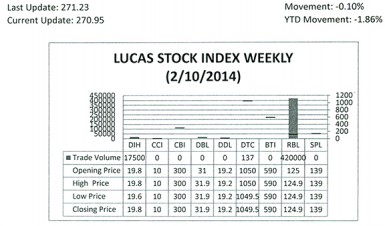Commitment to hygiene
According to the World Health Organization (WHO), sanitation is about the provision of facilities and services for the safe disposal of human waste. It is also about the maintenance of hygienic conditions through services such as garbage collection and waste water disposal. Sanitation therefore requires a network of infrastructure that permits the safe collection, storage and disposal of solid waste and the conduit of clean and waste water. It also requires a commitment to hygiene. Guyana has long had well-established national institutions and agencies overseeing sanitation. Yet, a look at the condition of Georgetown and its environs today contradicts that truth. The current deplorable state of affairs leaves one wondering to what degree the people of Guyana understand that the disposal of all waste generated is a personal responsibility for which they are all accountable. Not many Guyanese seem to realize that they are the reason Georgetown and its environs look as untidy and as unattractive as they do.
Stagnant and filthy repositories
Georgetown is a far cry from the garden city that it once was. Despite being invaded by modern architecture, Georgetown now looks like a special kind of multi-cell landfill. Piles of garbage could be found in almost any open space, on virtually every street and practically in every canal. The gutters and alleyways caress food containers, bottles, rags and other debris. Where water was once visible and flowing freely in alleyways, it has been buried by jungles of shrubbery. Adjacent to, and over, these now stagnant and filthy repositories, there is a mad scramble to erect the largest buildings that the soil could take sometimes without any consideration for the surrounding landscape. The tight spaces between many of the buildings also serve as one more holding cell in the vast garbage landfill that Georgetown has become. When the construction is done, some of the unused building materials fill the water conduits and block the movement of water while at the same time causing the gutters to become shallower and overflow their tops. These images are not confined to private property. Public buildings, including areas around police barracks and stations suffer from the same environmental indignities.
According to Guyana Water Incor-porated (GWI), the flooding that follows often contains sewage, seepages or animal faecal matter thereby contaminating tap water when flood waters seep into the pipelines. Consequently, not even the authority on water for household consumption could speak with confidence about the quality of the potable water coming through the taps.
Junction
 In anticipating budget allocations for sanitation in 2014, it must be kept in mind that sanitation is at the junction of clean water and a healthy lifestyle. Sanitation straddles both the health sector and the water sector, and well-directed expenditures on water and sanitation could lead to significant cost reductions in expenditures on healthcare. A focus on sanitation as it is with nutrition, prenatal care and similar types of early intervention would in effect be a focus on preventive healthcare. Spending on water therefore could lead to improved sanitation. From observation, the major problem with sanitation in Guyana is getting residents to stop littering, to carefully store their garbage until the garbage trucks could collect it, to keep their drains in proper order so that water flows freely and to have access to safe and clean water for good hygiene and effective human waste disposal. This strategic interrelationship among the many vital parts of sanitation has not been that evident in the budget proposals.
In anticipating budget allocations for sanitation in 2014, it must be kept in mind that sanitation is at the junction of clean water and a healthy lifestyle. Sanitation straddles both the health sector and the water sector, and well-directed expenditures on water and sanitation could lead to significant cost reductions in expenditures on healthcare. A focus on sanitation as it is with nutrition, prenatal care and similar types of early intervention would in effect be a focus on preventive healthcare. Spending on water therefore could lead to improved sanitation. From observation, the major problem with sanitation in Guyana is getting residents to stop littering, to carefully store their garbage until the garbage trucks could collect it, to keep their drains in proper order so that water flows freely and to have access to safe and clean water for good hygiene and effective human waste disposal. This strategic interrelationship among the many vital parts of sanitation has not been that evident in the budget proposals.
Budgetary allocation

The Lucas Stock Index (LSI) declined 0.10 percent in trading during the second week of February 2014. The stocks of three companies were traded with a total of 437,637 shares changing hands. There were two Climbers and one Tumbler. The shares of Banks DIH (DIH) fell 1.01 percent while those of Demerara Tobacco Company (DTC) and Republic Bank Limited (RBL) rose 0.05 and 0.08 percent respectively.
The thrust of public spending on preventive healthcare has to be directed at safe and effective waste disposal, the adequate provision of clean and safe drinking water through the water pipelines and the maintenance of the gutters and alleyways to prevent contamination and pest infestation. These are all preventive healthcare measures that feed off of each other. Garbage would not get into the drains if it is stored properly. The commitment of the nation to preventive healthcare is often reflected in the national budget. Therein the outlines of that commitment are expressed in the policy lines of water and sanitation. In the context of sanitation, drainage is also important to keep the water flowing and from settling on the land and becoming a breeding ground for mosquitoes and other carriers of disease. In recent times, drainage focuses on agriculture and not on the living conditions of the people. As the budgetary allocation on this issue over the last six years is examined, one must ask if the level of interest of the administration in sanitation matches the level of concern of the population.
Inter-sectoral relationship
Despite its importance to the health and hygiene of the people, the issue of sanitation does not command singular attention in the national budget proposal. Justifiably, the matter could be examined from several contexts because of its inter-sectoral relationship to water, drainage, housing, health and education. In examining the 2008 budget statement, sanitation was combined with housing and water. The focus on sanitation in Georgetown, the largest population centre, was very narrow. The effort at that time also appeared rather tentative and conservative with a focus on rehabilitating a septage facility and one sewer pump station. Beyond Georgetown, the focus also appeared limited with the intent to spend money on building four holding centres in Regions 2, 3 and 7. During that period, the sore eye that was the Mandela landfill existed. The fly population soared and the stench was unbearable for residents on the frontline of the dumpsite.
Improve public health
A total of $2.5 billion was allocated in 2009 for water and sanitation. Expenditure on sanitation continued to be minimal and narrowly focused in 2009 since the bulk of the money allocated was designated for water. Sanitation activities were limited to ongoing rehabilitative works and the development of waste management plans for Neighbourhood Democratic Councils (NDCs). A shift was made in 2011 to a safer and more efficient sanitation system that could help improve public health and sustainable economic development. The policy lines consist of a National and Regional Solid Waste Management System and the Georgetown Sanitation Improvement Programme. The focus of the work is to improve or rehabilitate nine sewer pumping stations within the Georgetown sewer network.
Operational performance
Under the Solid Waste Management Programme the Haags Bosch facility for waste disposal has been built. Over the last four years, a total of $4.6 billion has been spent on these projects. There is a garbage collection system in place and the Haags Bosch facility would certainly help to keep the garbage off the streets. But that requires the willingness of the people to act responsibly. The ‘Pick it Up’ campaign launched a few years ago does not seem to be conveying the correct message. Guyanese need to stop dropping things on the ground and start placing their waste in the bins and baskets on the road. The work on the Georgetown Sanitation Improvement Programme is ongoing. Once completed, the project should help improve the operational performance of the Georgetown sewerage system. That project however addresses the needs of 14 per cent of the area residents.
Education and awareness
None of that would matter if the drainage of the city is not addressed with urgency. This writer does not know the full scope of the problem, but the situation is particularly acute in the south Georgetown area where drains either have disappeared or lost their shape and character. As a result, flooding occurs easily and the risk of water borne disease is high. It is this aspect of sanitation that needs to be addressed and the budgets of years passed have overlooked. There is a need therefore for a policy shift in the area of sanitation. Moneys should be allocated in the 2014 budget and in future budgets to tackle education and awareness so that residents could act more responsibly in their immediate surroundings. A programme is needed also to rehabilitate many drains and to dredge canals that have lost their capacity to handle the water flow. Less than one per cent of the budget is allocated to sanitation. That needs to change if Guyana is to see significant improvements in its sanitation situation.








